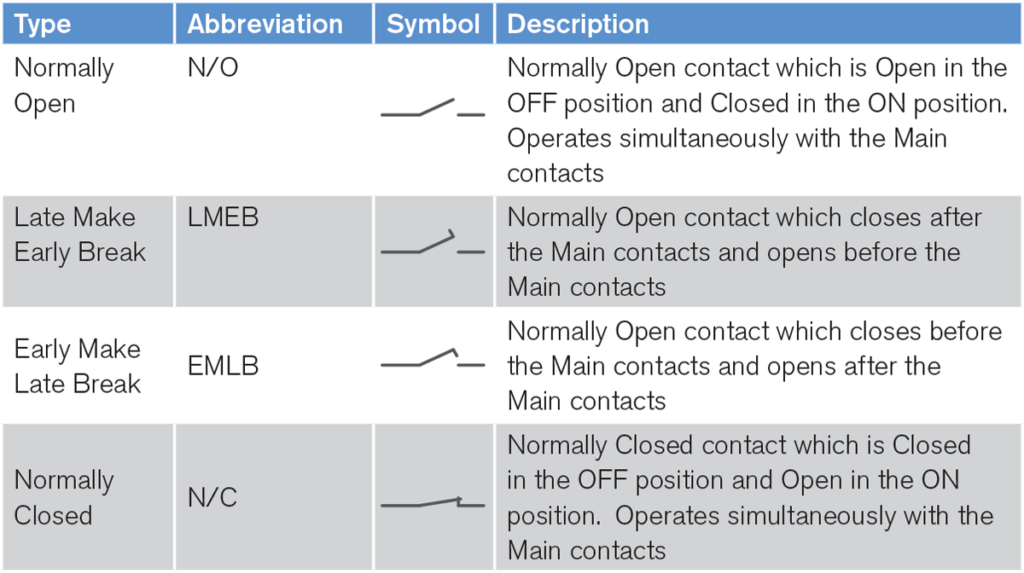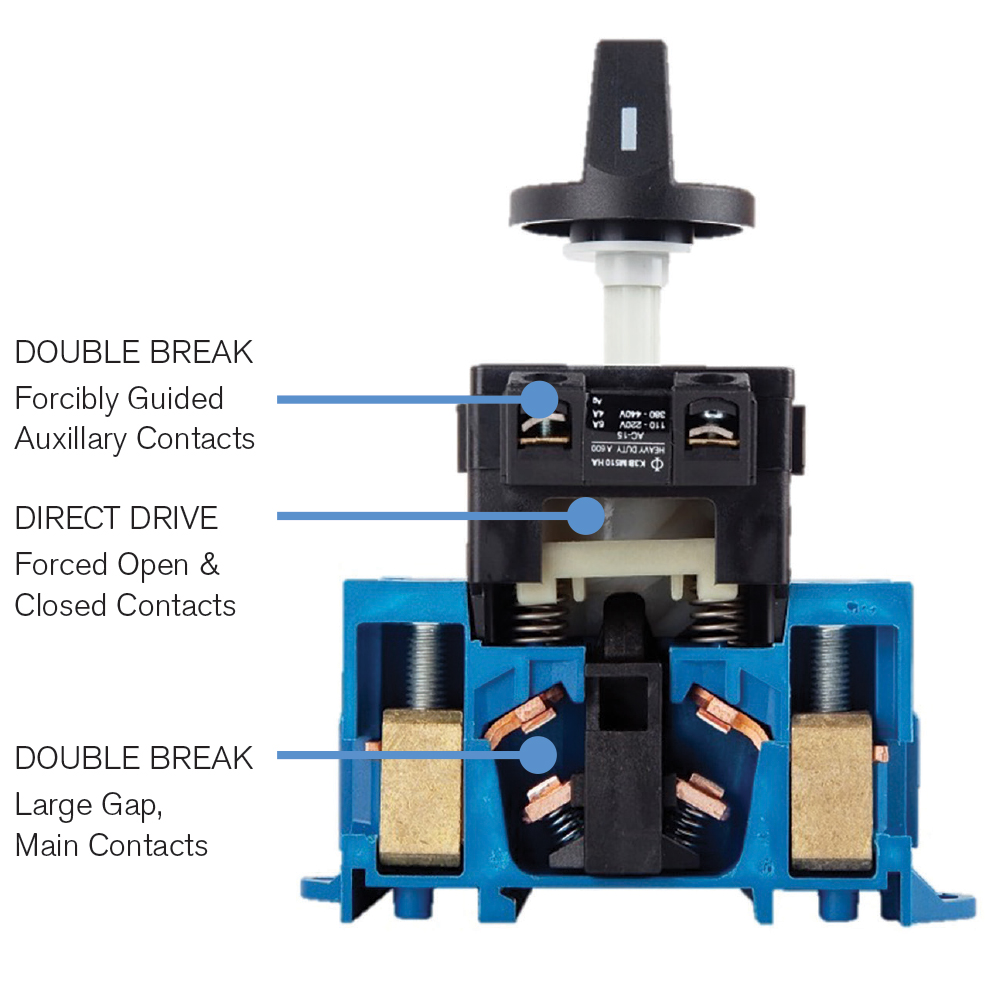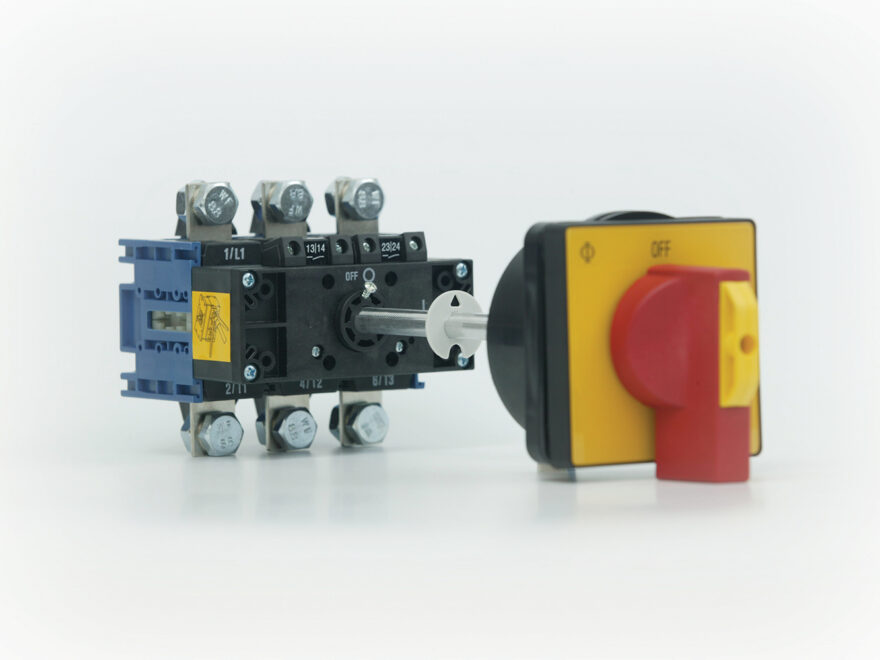Previous articles on Isolators have discussed product design features that ensure the safe and assured switching of mains and load circuits, and now the important role that normally open & normally closed auxiliary contacts play in control and safety circuits, will be explored.
‘Auxiliary’ is a term that often infers less responsibility or importance than a ‘Main’ role in many instances. Movies and armed forces are two examples that come to mind where ‘failure’ of the main role has much more severe consequences than failure of an auxiliary role.
As we know, should the Main actor in a movie perform poorly, the movie becomes a box office flop; and with an army should the Main force be inadequate a battle or even the entire war may be lost.
In the above two examples, the auxiliary roles are highly important respectively, however neither can compensate for failure in the Main role.
Conversely, specially designed auxiliary contacts on Isolators play an equally important role as the Main contacts when wired in series with parallel control and safety circuits.
Contact Function
The types of auxiliaries relevant to this article are as listed below:

Typical Applications
Normally Open – N/O
A N/O contact opens and closes simultaneously with the Main contacts and is used to signal if the Isolator is in the ON position.
- Often used to tell a BMS (Building Management System) the status of
the Isolator. - Wired to an indicator light to show the Isolator is Closed
Late Make Early Break – LMEB
The LMEB N/O contact operates as follows;
- When the isolator is turned ON, the auxiliary contact closes after the main contacts close.
- When the isolator is turned OFF, the auxiliary contact opens before the main contacts open.
There are two very popular applications for this auxiliary;
- Avoid Nuisance Faults at VSDs when the Isolator is turned OFF.
If mains power is removed from a VSD before the control power, the VSD detects a mains phase failure and goes into a fault condition. When the LMEB auxiliary is wired to the run signal of a VSD, it removes control power prior to the removal of 3-phase power and a ‘ghost fault’ is avoided. - Enables an ON-Load Isolator to be rated as an OFF-Load Isolator
Early Make Late Break – EMLB
The EMLB N/O contact operates as follows:
When the isolator is turned ON, the auxiliary contact closes before the main contacts close.
When the isolator is turned OFF, the auxiliary contact opens after the main contacts open.
A EMLB aux contact may be used for the following application:
To release an electric brake fitted to an electric motor before the Isolator contacts are closed, this will also only allow the brake to be re-applied once the main Isolator contacts have opened.
Normally closed – N/C
A normally closed contact is closed in the off position, and open in the ON position. It opens and closes simultaneously with the main contacts.
N/C aux contacts are often used as an electrical interlock to prevent another piece of equipment or process from being inadvertently started when the isolator is in the “ON” position.
Safety Rated Auxiliary Contacts
To be compliant for use in Safety Circuits in series with emergency stops and safety relays, auxiliary contacts shall have Positive Opening Double Break contact systems, as explained below.
1. Positive opening operation
Positive opening operation is where the mechanical actuator (push rod) forces the contact open even if it is welded closed. The use of a flexible actuator is non-compliant. This is a key feature that distinguishes a safety rated contact from
a typical ‘relay’ contact.
2. Double Break Contact System
A double break contact ensures there are two opening contact points satisfying machinery safety requirements of the relevant standard. All Kraus & Naimer N/O auxiliary contacts comply as Safety Contacts.

Double Break Safety Contact
Safety rated auxiliary contacts shall be permanently connected to the switch body, this feature avoids the possibility of the auxiliary contacts becoming separated from the switch due to environmental causes such as shock and vibration.
Process Control Auxiliary Contacts
Process control and safety circuits are often low voltage and low current, and the environment where the isolators are installed can be somewhat contaminated.
Manufacturers such as Kraus & Naimer have a range of auxiliary contacts with special contact systems designed specifically for use in these applications to ensure safe and reliable operation. Auxiliaries with gold and silver contacts and 2 or 4 contact points provide high contact reliability and electronic compatibility.
Ratings for the various switches and auxiliaries are shown below.
Kraus & Naimer Auxiliary Ratings

Summary
Auxiliary contacts are used in many ways and their quantity or normal condition can vary to suit the application.
When selecting an isolator it is important to consider the application and safety level that is appropriate. Positive contact movement, double break forced opening contacts are amongst the features that should be present when an isolator and its auxiliaries are to be safety rated.
Purpose designed Isolators such as the Kraus & Naimer KG series meet or exceed the relevant product and safety standards and have the option of both cam driven and lateral mounted auxiliaries.
When a safety rated switch is required, the above information should assist in the selection of a product that is compliant and reliable.


